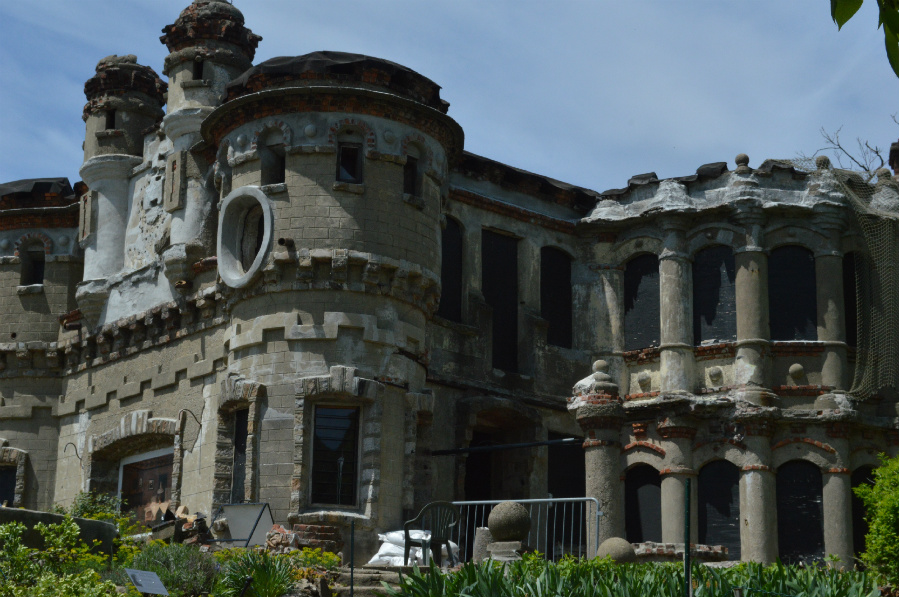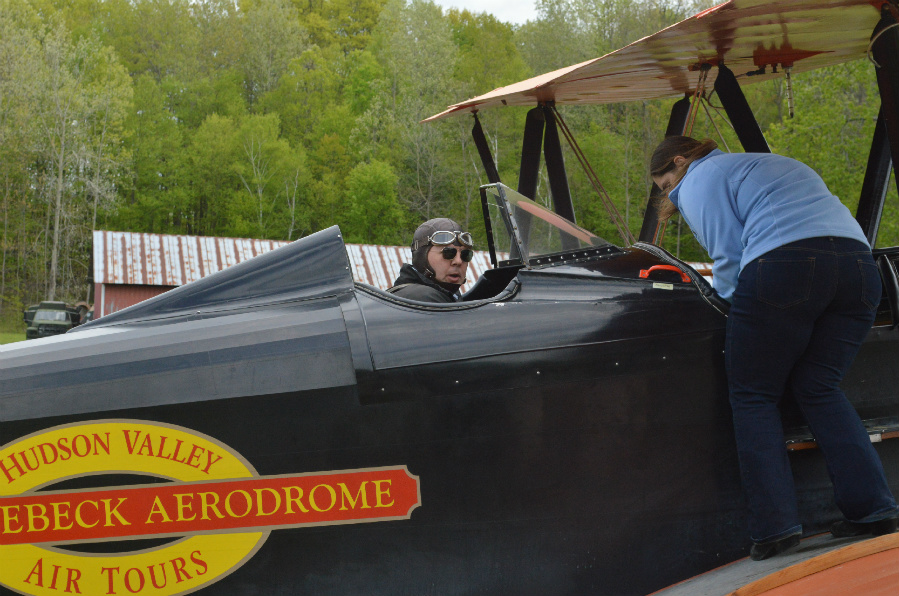By Bob & Sandy Nesoff: June 29, 2017
 Bannerman’s Castle
Bannerman’s Castle
Somehow or other destinations at a distance always seem to be more exotic and interesting than those in our own backyards. Nearby New York puts the lie to those assumptions.
There is a host of opportunities for a day’s outing within two hours of Times Square. And most of them will make you feel as though you are a world away.
Beacon, NY, easily reached by car or Metro-North brings you to a short boat ride to Bannerman’s Island.
Old Rhinebeck Aerodrome, with its fabulous vintage aircraft, is more easily reached by car, but there are also train options available.
Bannerman’s Island, set in the Hudson River, is home to the remains of Bannerman’s Castle, an imposing fortress that today is little more than a shell of what it was when built in the early 1900s.
Anyone who has ever taken a boat ride on the Hudson River North has seen an enigma overlooking the water from a tree-shaded promontory. You could be sailing the Danube and spotting the ruins of an ancient castle bearing the scars of the Hundred Years War. Bannerman’s Castle, or what’s left of it, beckons investigation. Until not all those many years ago it was a haven for vandals and their graffiti markers, lovers looking for a sanctuary from prying eyes and those who simply wanted to wander one of the few remaining wildernesses.
The island’s history took if from a refuge for vandals to a home for weapons and munitions and back to vandals once again. Today it is a state park undergoing a massive restoration to bring as much of it as possible back to its glory days.
The “Castle” built by Frank Bannerman to store military surplus items is an imposing, if dark presence looming over the river. Most of it today is prevented from becoming a pile of bricks by steel struts supporting the walls that remain. Construction began in 1901 with the intent of making it look like an old Scottish castle similar to the ones in Frank Bannerman’s homeland.
Originally named Pollepel Island, it later took on the more familiar Bannerman’s Island. It has a rich history that harkens back to the Revolution where skirmishes with the British forces took place.
Bannerman became a multi-millionaire by purchasing everything military surplus, storing it on the island and selling weapons, munitions, military clothing, helmets and whatnot to small armies around the world.
A short walk to the high point of the island brings you to the old mansion house, an amazing building with a commanding view across the river. While this too became a derelict over the years with trees actually rowing from inside the building through the roof, it will soon be restored to its former glory. Restoration work is an ongoing project and results are already visible.
The island has been turned into a cultural attraction with regularly scheduled shows running on the third Sunday of the month through October. Everything from Irish and Bluegrass to Modern Acoustical Rock is presented. The shows are held in the island’s gardens.
But music isn’t the only attraction. On June 17, Douglas Taurel’s production of “The American Soldier” tells the stories of soldiers and their families, culled from letters written from the Revolutionary War to Afghanistan.
Classical buffs can get their fill on July 15 and 16 with a production of Romeo and Juliet. Other planned shows include Whiskey Women on Aug. 19 and War of the Worlds on Sept. 16.
The island is easily reached by the Bannerman Castle Trust near the Metro-North station in Beacon.
 Old Rhinebeck Aerodrome
Old Rhinebeck Aerodrome
For something more “flighty” and adrenaline pumping, Old Rhinebeck Aerodrome and its vintage aircraft is the stop to see. Founder Cole Palen believed it was not an airplane if it did not fly. Keeping true to his word the museum today ensures that a variety of ancient aircraft are still considered “airplanes.”
OK, let’s face it. Old Rhinebeck Aerodrome isn’t exactly JFK. It’s not even Teterboro. But the road to access it from the Thruway and several major highways is very well marked. Even the Red Baron wouldn’t get lost.
There’s a more than ample parking lot across from the entrance, but you have to go up the hill (drive, don’t walk) to the museum at the top to purchase entry tix. Then come back down, park and walk across the road to the entrance. If you’re there on a weekend you’ll hear the ancient engines revving in preparation for a run down the grass strip for takeoff.
If watching these old craft doesn’t get your blood pumping, go home and play canasta.
There is a great variety of aircraft ranging from an old German Fokker to a recreation of Charles Lindberg’s Spirit of St. Louis undergoing work in preparation for its maiden flight.
Adding to the experience are the era-appropriate flyboys in vintage uniforms, old military vehicles and the variety of aircraft sitting in hangers and on the grass waiting to go airborne.
There are four iconic original WW l vehicles: an M1917 light tank, 1917 Columbia Ambulance that was used to transport wounded, a 1918 Curtis JN-4 “Jenny” training aircraft used in war service, and a 1918 Thomas Morse S4-B American fighter that was shipped to the front too late to make it into the war. On display are more than 60 aircraft and more than 40 antique automobiles from 1900-1938.
Every Sunday from mid-June through October features Allied and Central Powers fighters in flight and mock combat. On Saturdays, air shows chronicle the History of Flight from beginning to the 1930s.
For those with some adventure in their bodies, take a flight in one of the old craft, circle over the countryside and look down on some of the most beautiful estates in the country. The aircraft used are ancient double, open cockpit biplanes of the sort you might see in a Wonder Woman or Captain America movie.
The flights are surprisingly smooth from takeoff to landing. This is a thrill, flying in a double open cockpit biplane, that you’ll long remember. The cost is $75 p/p.
You’ll be flying in a 1929 New Standard D-25 biplane powered by a Wright Whirlwind engine of the type that took the Spirit of St. Louis across the Atlantic.
This is one of the greatest family outings available in the Northeast. School and other groups can be accommodated on weekdays.
After leaving the Aerodrome head for the village of Rhinebeck, a short drive away. Check out the old buildings and the quaint little shops. It’ll make for an amazing day to remember.
Photos by Bob & Sandy Nesoff
Follow UrbanMatter New York on Facebook and Twitter for daily updates on local events and news.


